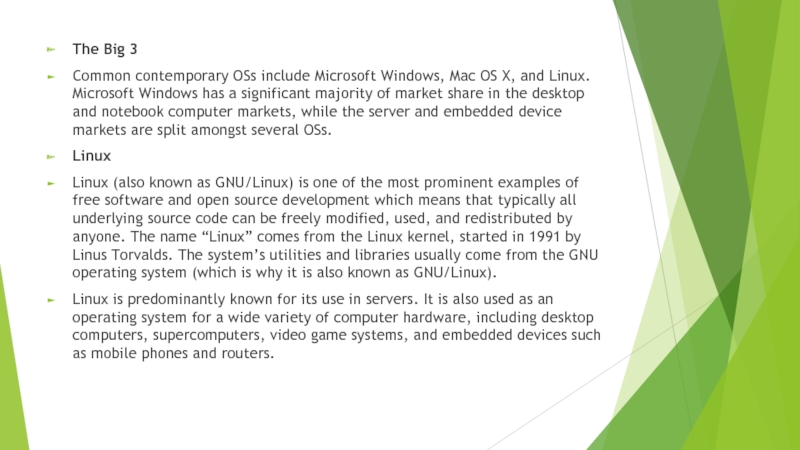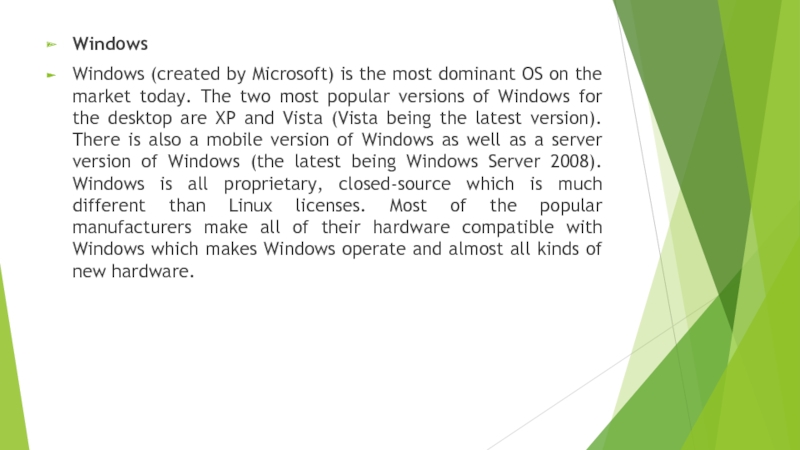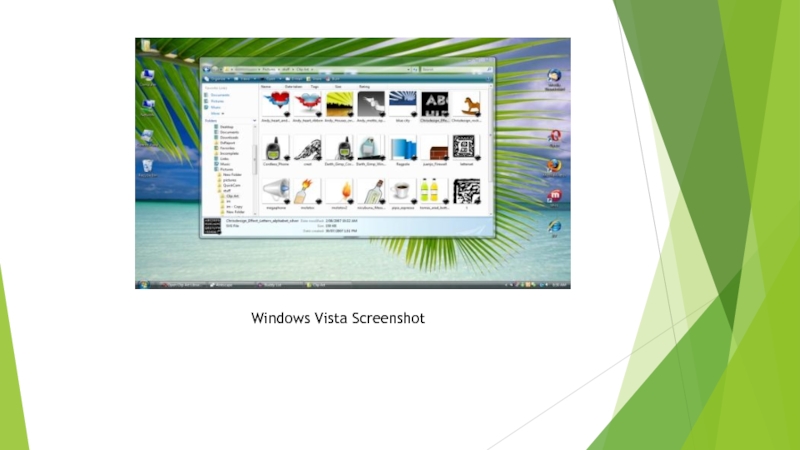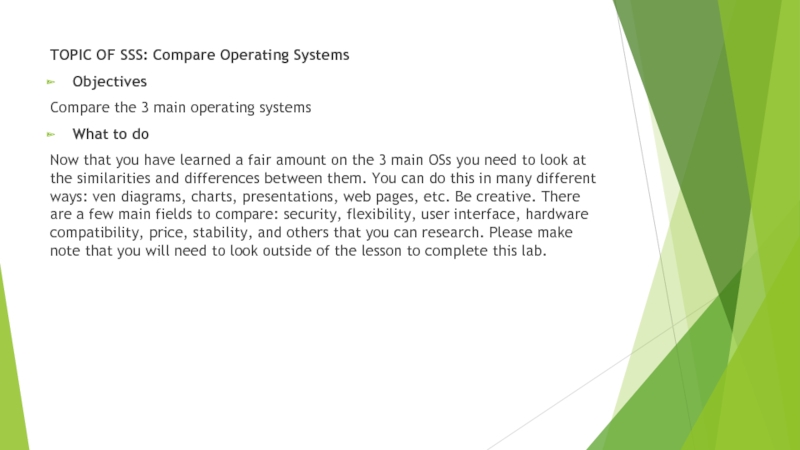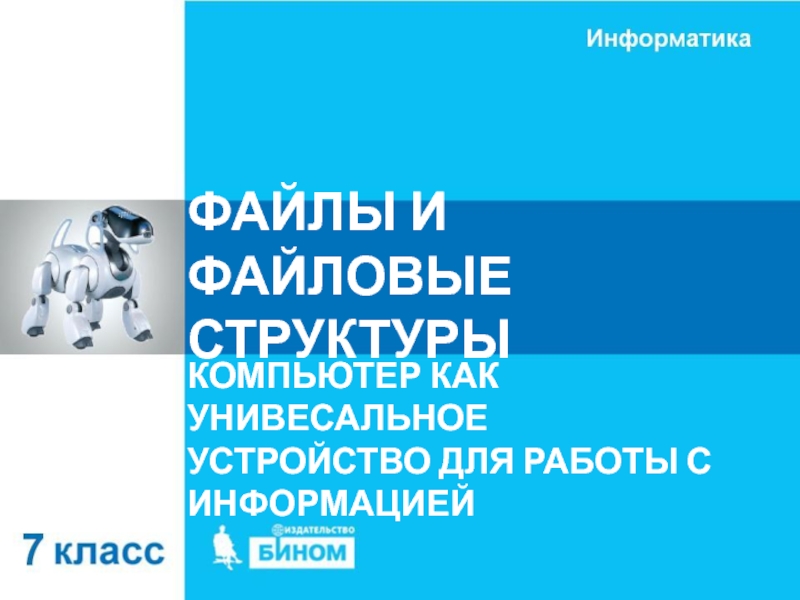- Главная
- Разное
- Дизайн
- Бизнес и предпринимательство
- Аналитика
- Образование
- Развлечения
- Красота и здоровье
- Финансы
- Государство
- Путешествия
- Спорт
- Недвижимость
- Армия
- Графика
- Культурология
- Еда и кулинария
- Лингвистика
- Английский язык
- Астрономия
- Алгебра
- Биология
- География
- Детские презентации
- Информатика
- История
- Литература
- Маркетинг
- Математика
- Медицина
- Менеджмент
- Музыка
- МХК
- Немецкий язык
- ОБЖ
- Обществознание
- Окружающий мир
- Педагогика
- Русский язык
- Технология
- Физика
- Философия
- Химия
- Шаблоны, картинки для презентаций
- Экология
- Экономика
- Юриспруденция
Introduction to operation systems (OS) презентация
Содержание
- 1. Introduction to operation systems (OS)
- 2. Operating Systems An operating system (OS)
- 3. The Big 3 Common contemporary OSs include
- 4. Design Linux is a modular Unix-like OS.
- 5. Windows Windows (created by Microsoft) is the
- 6. XP The term “XP” stands for experience.
- 7. Windows XP has released a set of
- 8. Vista Windows Vista contains many changes and
- 9. Windows Vista Screenshot
- 10. OS X OS X is the major
- 11. OS X Taskbar The Finder does exactly
- 13. TOPIC OF SSS: Compare Operating Systems Objectives
Слайд 2Operating Systems
An operating system (OS) is the software component of a
computer system that is responsible for the management and coordination of activities and the sharing of the resources of the computer. The OS acts as a host for application programs that are run on the machine. As a host, one of the purposes of an OS is to handle the details of the operation of the hardware. This relieves application programs from having to manage these details and makes it easier to write applications. Almost all computers use an OS of some type.
OSs offer a number of services to application programs and users. Applications access these services through application programming interfaces (APIs) or system calls. By using these interfaces, the application can request a service from the OS, pass parameters, and receive the results of the operation. Users may also interact with the OS by typing commands or using a graphical user interface (GUI).
OSs offer a number of services to application programs and users. Applications access these services through application programming interfaces (APIs) or system calls. By using these interfaces, the application can request a service from the OS, pass parameters, and receive the results of the operation. Users may also interact with the OS by typing commands or using a graphical user interface (GUI).
Слайд 3The Big 3
Common contemporary OSs include Microsoft Windows, Mac OS X,
and Linux. Microsoft Windows has a significant majority of market share in the desktop and notebook computer markets, while the server and embedded device markets are split amongst several OSs.
Linux
Linux (also known as GNU/Linux) is one of the most prominent examples of free software and open source development which means that typically all underlying source code can be freely modified, used, and redistributed by anyone. The name “Linux” comes from the Linux kernel, started in 1991 by Linus Torvalds. The system’s utilities and libraries usually come from the GNU operating system (which is why it is also known as GNU/Linux).
Linux is predominantly known for its use in servers. It is also used as an operating system for a wide variety of computer hardware, including desktop computers, supercomputers, video game systems, and embedded devices such as mobile phones and routers.
Linux
Linux (also known as GNU/Linux) is one of the most prominent examples of free software and open source development which means that typically all underlying source code can be freely modified, used, and redistributed by anyone. The name “Linux” comes from the Linux kernel, started in 1991 by Linus Torvalds. The system’s utilities and libraries usually come from the GNU operating system (which is why it is also known as GNU/Linux).
Linux is predominantly known for its use in servers. It is also used as an operating system for a wide variety of computer hardware, including desktop computers, supercomputers, video game systems, and embedded devices such as mobile phones and routers.
Слайд 4Design
Linux is a modular Unix-like OS. It derives much of its
basic design from principles established in Unix during the 1970s and 1980s. Linux uses a monolithic kernel which handles process control, networking, and peripheral and file system access. The device drivers are integrated directly with the kernel. Much of Linux’s higher-level functionality is provided by seperate projects which interface with the kernel. The GNU userland is an important part of most Linux systems, providing the shell and Unix tools which carry out many basic OS tasks. On top of the kernel, these tools form a Linux system with a GUI that can be used, usually running in the X Windows System (X).
Слайд 5Windows
Windows (created by Microsoft) is the most dominant OS on the
market today. The two most popular versions of Windows for the desktop are XP and Vista (Vista being the latest version). There is also a mobile version of Windows as well as a server version of Windows (the latest being Windows Server 2008). Windows is all proprietary, closed-source which is much different than Linux licenses. Most of the popular manufacturers make all of their hardware compatible with Windows which makes Windows operate and almost all kinds of new hardware.
Слайд 6XP
The term “XP” stands for experience. Windows XP is the successor
to both Windows 2000 Professional and Windows ME. Within XP there are 2 main editions: Home and Professional. The Professional version has additional features and is targeted at power users and business clients. There is also a Media Center version that has additional multimedia features enhancing the ability to record and watch TV shows, view DVD movies, and listen to music.
Windows XP features a task-based GUI. XP analyzes the performance impact of visual effects and uses this to determine whether to enable them, so as to prevent the new functionaility from consuming excessive additional processing overhead. The different themes are controlled by the user changing their preferences.
Windows XP features a task-based GUI. XP analyzes the performance impact of visual effects and uses this to determine whether to enable them, so as to prevent the new functionaility from consuming excessive additional processing overhead. The different themes are controlled by the user changing their preferences.
Слайд 7Windows XP has released a set of service packs (currently there
are 3) which fix problems and add features. Each service pack is a superset of all previous service packs and patches so that only the latest service pack needs to be installed, and also includes new revisions. Support for Windows XP Service Pack 2 will end on July 13, 2010 (6 years after its general ability).
Windows XP Screenshot
Слайд 8Vista
Windows Vista contains many changes and new features from XP, including
an update GUI and visual style, improved searching features, new multimedia creation tools, and redesigned networking, audio, print, and display sub-systems. Vista also aims to increase the level of communication between machines on a home network, using peer-to-peer technology to simplify sharing files and digital media between computers and devices.
Windows vista is intended to be a technology-based release, to provide a base to include advanced technologies, any of which are related to how the system functions and thus not readily visible to the user. An example is the complete restructuring of the architecture of the audio, print, display, and networking subsystems; while the results of this work are visible to software developers, end-users will only see what appear to be evolutionary changes in the UI.
Windows vista is intended to be a technology-based release, to provide a base to include advanced technologies, any of which are related to how the system functions and thus not readily visible to the user. An example is the complete restructuring of the architecture of the audio, print, display, and networking subsystems; while the results of this work are visible to software developers, end-users will only see what appear to be evolutionary changes in the UI.
Слайд 10OS X
OS X is the major operating system that is created
by Apple Inc. Unlike its predecessor (referred to Classic or OS 9), OS X is a UNIX based operating system. Currently OS X is in version 10.5, with 10.5.3 being the last major software update and plans for 10.6 having been announced. Apple has chosen to name each version of OS X after a large cat with 10.0 being Cheetah, 10.1 as Puma, 10.2 as Jaguar, 10.3 as Panther, 10.4 as Tiger, 10.5 as Leopard, and the unreleased 10.6 named Snow Leopard.
Apple also develops a server OS X that is very similar to the normal OS X, but is designed to work on Apple’s X-Serve hardware. Some of the tools included with the server OS X are workgroup management and administration software that provide simplified access to common network services, including a mail transfer agent, a Samba server, an LDAP server, a domain name server, a graphical interface for distributed computing (which Apple calls Xgrid Admin), and others.
Apple also develops a server OS X that is very similar to the normal OS X, but is designed to work on Apple’s X-Serve hardware. Some of the tools included with the server OS X are workgroup management and administration software that provide simplified access to common network services, including a mail transfer agent, a Samba server, an LDAP server, a domain name server, a graphical interface for distributed computing (which Apple calls Xgrid Admin), and others.
Слайд 11OS X Taskbar
The Finder does exactly what it says it does.
It finds everything in your machine. This is how you find all of the documents, applications, movies, music, photos, and whatever else you have stored on your machine. There are four ways to view the contents of the directory you’re looking at that are chosen from the four icons at the top left of the window: icons, list, column, or Cover Flow. The icon and list views are pretty standard, but the column and Cover Flow views are fairly unique to OS X.
Слайд 13TOPIC OF SSS: Compare Operating Systems
Objectives
Compare the 3 main operating systems
What
to do
Now that you have learned a fair amount on the 3 main OSs you need to look at the similarities and differences between them. You can do this in many different ways: ven diagrams, charts, presentations, web pages, etc. Be creative. There are a few main fields to compare: security, flexibility, user interface, hardware compatibility, price, stability, and others that you can research. Please make note that you will need to look outside of the lesson to complete this lab.
Now that you have learned a fair amount on the 3 main OSs you need to look at the similarities and differences between them. You can do this in many different ways: ven diagrams, charts, presentations, web pages, etc. Be creative. There are a few main fields to compare: security, flexibility, user interface, hardware compatibility, price, stability, and others that you can research. Please make note that you will need to look outside of the lesson to complete this lab.


